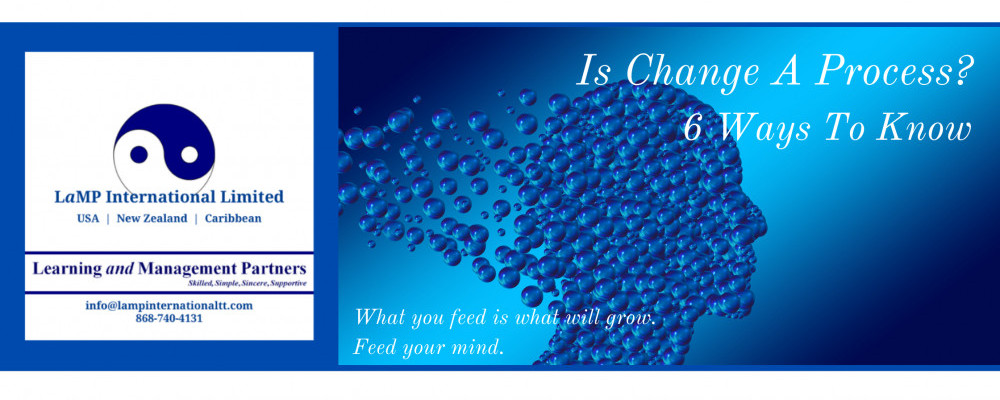
How Change Happens
One of the fundamental misunderstandings about change is that it can take place after one simple intervention. One occurrence or one event. Very few people stop to question: Is change a process?
Working within organisations over the years I have been very surprised that, after one conversation, training program or performance review, people walk away with a deep-rooted belief that change will happen. They actually expect that the individual will return the next day, a different human being.
That never ceases to cause my head to shake – vigorously – from left to right. If change occurs like lightening, consider it a miracle or the result of unseen changes that were out of your purview.
Here are 6 ways to know about this journey called change.
1. A Sense Of Urgency
Amongst all the change models and gurus, this may be the most agreed aspect of change, and the first step towards it. Unless there is an urgent, do-or-die reason for change it probably will not happen any time soon. There must be a strong, collective and compelling reason to move from one state of being to another
Urgency provides the motivation and enables the movement to adapt and become something different.
Quite frequently though, it is the carrot and the stick philosophy that is used to kick-start the process and appeal to the emotional buy-in necessary. Parenting and organisations are excellent to observe this.
Do you want better grades? Reward with a new bike or punish by taking away the cell phone for a week or two.
Performance at work not where it should be? Stop the verbal reminders and start writing. Make sure to document a timeline for the expected change, together with a reduction in performance bonus or no annual salary increase.
Of course, nothing makes for more urgency than an organisation facing closure and the separation of employees.
2. A Vision For Change
“Without vision, people perish.”
If you want to move people from one place to another, you have to be able to help them visualise where they are going, how they are going to get there and what things would be like when they achieve the change. This is directly connected to that well-known phrase:
“What’s In It For Me?” (WIIFM)
Not many people will be inclined to go somewhere they do not know. The more attractive that you can make the journey, the better. A vision creates expectations and gives people something to look forward to – the reasons for making the change and doing what is required.
As you share the vision, make sure that you are creating ownership. Find aspects of the vision that each person can relate to and contribute to. In this way, everyone will feel involved and responsible.
3. Strength In Unity
“Even the weak become strong when they are united.”
Bringing people together for a connecting reason or cause makes the journey that much easier and sometimes, shorter. There are many stories about groups of people achieving what may seem to be impossible to an individual or a few.
We feed off of each other. The energy, the emotions, the support all motivate us to push on and keep moving towards the shared vision. With unified strength, the thought of leaving a group member behind becomes almost unpalatable as each person’s contribution is valued.

This is what team work is really about, isn’t it? Building and moving using the strengths of each member. The more you focus on the strengths, the less the weaknesses seem to matter and the more output people seem to tap into themselves and harness.
We all like to feel appreciated, valued and of importance. The more of those emotions we receive, the more we are compelled to give back. This cycle creates a momentum, a force that creates energy and movement and propels us towards the vision, almost like a bird taking flight.
4. Allow Leaders To Lead
Leadership is not a title or a position. When it comes to change and leading the charge, it is highly advisable that you make space for the leaders – formal and informal – to take charge.
What you are looking for is influence. People within the community or environment who are highly respected and who have a bag full of credibility with their members. Leadership, like respect, is earned. Having a position may not necessarily mean that people relate to you as a leader and look to you for direction.
An effective leader will acknowledge the strengths and abilities of others, take pride in their contributions and accomplishments and ensure that they have the resources that they need to perform and contribute.
When the time comes for a leader to follow, for the benefit of the group or team, s/he will humbly and willingly adjust roles.
5. Communicate With Colour
When it comes to communicating the change and the messages, use colour. In other words, communicate frequently and use every available opportunity to reinforce your vision and compelling reasons. Communication, like the process itself, is not a one-time event or destination.
You should use communication to feed the energy you want to create and to keep your team united. A big mistake that is made during times of change is to mis or under communicate. This leaves room for doubt and the creation of disconnected messages that could eventually negatively impact the vision.
The more you communicate, the more you learn and the more opportunities you create to remove any distractions or obstacles that may arise. It also allows you to understand your team and group members better to facilitate more effective mobilisation.
Communication is the language of leadership.
Listen, observe, discuss, share.
6. Smell The Roses
Change is difficult. At times, it can even be violent.
As adaptable as we may be, change does impact us emotionally, physically, mentally and behaviourally. This is why it is important to take time out along the journey to celebrate the little achievements and recognise the efforts being put forward. Too little of this is ever done.
There is a thinking that people would only want tangible rewards like money but this is far from the truth. Simple recognition – a note to acknowledge a contribution, a public “thank you” for a job well done or some time away to spend with family or loved ones can have a profound impact on people’s motivation.
We often underestimate the influence of the little things and they become overlooked. This could lead people to thinking that it is only when they achieve big things that it would matter or have any meaningful impact. The little things add up though and if not attended to they could create cracks that eventually become holes of disenchantment and dissatisfaction.
Celebrations create upliftment. The more you lift, the higher you will rise.

Change Is A Journey
There is no such thing as the event of change. Even if it appears to be an overnight happening, it took time to get there. With change comes adaptation, movement, metamorphosis and difference. It involves travel from one place to another; one behaviour to another; one goal to another.
Understanding these aspects of the process of change will help you to become a better facilitator and enabler.
Do you want to learn how to become a better Change Agent?
Leave a Comment below and let us know your thoughts on change, what resonated with this article or, how we may to be able to support your growth and development.
Subscribe to our Newsletter for more engaging articles, ebooks and first-hand insight to our workshops, seminars, webinars and training programmes.
Follow our Founder’s journey and change your life for the better.
 Cassandra is the Founder, Managing Director and Lead Partner at LaMP International Limited.
Cassandra is the Founder, Managing Director and Lead Partner at LaMP International Limited.
She is an internationally trained, experienced and versatile Executive, Facilitator, Speaker, Coach and Digital Entrepreneur. Her expertise in Organisational Behaviour, Change Management. Group Work, Communications, Talent Development and Strategic Human Resources Management allow her to bring a unique and engaging style to the table.
When not in the dynamic business arena you can find her travelling the world with her daughter, writing, hiking, enjoying extreme sports, capturing life and nature or getting her hands dirty in the soil.


